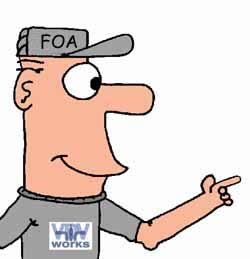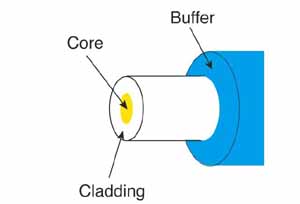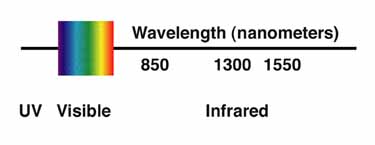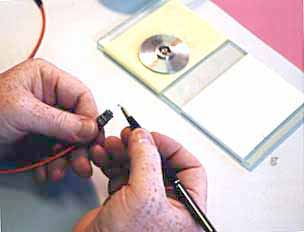
- Lennie Lightwave's
- Guide To Fiber Optics
Jargon
What is fiber optics?
Picture sending signals zipping along from one location to another in the form of light guided through thin fibers of glass or plastic. These signals can be analog or digital - voice, data or video information and fiber can transport more information longer distances in less time than any copper wire.
It's powerful and fast, fast, fast!
First get to know the language - the "jargon" - here's a list of terms you should get to know:
Metric System: Fiber Optics, as a universal technology, utilizes the metric system as the standard form of measurement. Several of the more common terms:
Meter: 39.37 inches.
Kilometer: 1000 meters / 3,281 feet / 0.62 miles.
Micron: 1/1,000,000 th of a meter. 25 microns equal 0.001 inch. This is the common term of measurement for fibers.
Nanometer: One billionth of one meter. This term is commonly used in the fiber optics industry to express wavelength (or color) of transmitted light.
Let's Start With Fiber
Optical Fiber: Thin strands of highly transparent glass or sometimes plastic that guide light.
Core: The center of the fiber where the light is transmitted.
Cladding: The outside optical layer of the fiber that traps the light in the core and guides it along - even through curves.
Buffer coating or primary coating: A hard plastic coating on the outside of the fiber that protects the glass from moisture or physical damage.
Mode: A single electromagnetic field pattern (think of a ray of light) that travels in fiber.
Multimode fiber: has a bigger core (almost always 62.5 microns - a micron is one one millionth of a meter - but sometimes 50 microns) and is used with LED sources at wavelengths of 850 and 1300 nm for short distance, lower speed networks like LANs.
Singlemode fiber: has a much smaller core, only about 9 microns, and is used for telephony and CATV with laser sources at 1300 and 1550 nm. It can go very long distances at very high speeds.
Most multimode and singlemode fibers have an outside diameter of 125 microns - about 5 thousandths of an inch - just slightly larger than a human hair. Each are coated with an acrylic buffer that doubles that size. Then it gets cabled.
Plastic optical fiber (POF): is a large core (about 1mm) multimode fiber that can be used for short, low speed networks. POF is used in consumer HiFi and starting to be used as part of a new standard for car communication systems called MOST (go to http://www.mostcooperation.com/)
For more on optical fiber, go here.
Terms that describe fiber optic cable:
Cable: Fiber needs protection to survive all the places it gets installed and it's the cable that provides it. Cables may have from one to hundreds of fibers inside.
 Jacket: The tough outer covering on the cable. Cables installed inside buildings must meet fire codes by using special jacketing materials.
Jacket: The tough outer covering on the cable. Cables installed inside buildings must meet fire codes by using special jacketing materials.
Strength members: Aramid fibers (Kevlar is the duPont trade name) used to pull the cable. The term is also used for the fiberglass rod in some cables used to stiffen it to prevent kinking.
Armor: Discourages rodents from chewing through it.
(Go here for more on cables)
Termination:
Connector: A non-permanent device for connecting two fibers or fibers to equipment  where they are expected to be disconnected occasionally for testing or rerouting. It also provides protection to both fibers. (Parts for an ST connector are shown.)
where they are expected to be disconnected occasionally for testing or rerouting. It also provides protection to both fibers. (Parts for an ST connector are shown.)
Ferrule: A tube which holds a fiber for alignment, usually part of a connector
Splice: a permanent joint between two fibers
Mechanical Splice: A splice where the fibers are aligned created by mechanical means
Fusion Splice: A splice created by welding or fusing two fibers together
Fusion Splicer: An instrument that splices fibers by fusing or welding them, typically by electrical arc.
Hardware: Terminations and Splices require hardware for protection and management: patch panels, splice closures, etc.
(Here's more on terminations)
Fiber Performance Specifications
Terms you use when you want to take your measurements:
Attenuation: The reduction in optical power as it passes along a fiber, usually expressed in decibels (dB). See optical loss
Bandwidth: The range of signal frequencies or bit rate within which a fiber optic component, link or network will operate.
Decibels (dB): A unit of measurement of optical power which indicates relative power. A -10 dB means a reduction in power by 10 times, -20 dB means another 10 times or 100 times overall, -30 means another 10 times or 1000 times overall and so on.
dB: Optical power referenced an arbitrary zero level
dBm: Optical power referenced to 1 milliwatt
Micron (m): A unit of measure used to measure wavelength of light.
Nanometer (nm): A unit of measure used to measure the wavelength of light (meaning one one-billilonth of a meter)
Optical Loss: The amount of optical power lost as light is transmitted through fiber, splices, couplers, etc, expressed in dB.
Optical Power: is measured in "dBm", or decibels referenced to one miliwatt of power. while loss is a relative reading, optical power is an absolute measurement, referenced to standards. You measure absolute power to test transmitters or receivers and relative power to test loss.
Scattering: The change of direction of light after striking small particles that causes loss in optical fibers and is used to make measurements by an OTDR
Wavelength: A term for the color of light, usually expressed in nanometers (nm) or microns (m). Fiber is mostly used in the infrared region where the light is invisible to the human eye.

Go here for more information on testing.
Terms that describe the tools you will need for installation and termination:
Jacket Slitter or Stripper: A cutter for removing the heavy outside jacket of cables
Fiber Stripper: A precise stripper used to remove the buffer coating of the fiber itself for termination. There at three types in common use, called by their trade names: "Miller Stripper", "No-Nik" and "Micro Strip."
Cleaver: A tool that precisely "breaks" the fiber to produce a flat end for polishing or splicing.
Scribe: A hard, sharp tool that scratches the fiber to allow cleaving.
Polishing Puck: for connectors that require polishing, the puck holds the connector in proper alignment to the polishing film.
Polishing Film: Fine grit film used to polish the end of the connector ferrule.
Crimper: A tool that crimps the connector to the aramid fibers in the cable to add mechanical strength.
Here is more information on termination.
Terms that describe test equipment you will need:
Optical Power Meter: An instrument that measures optical power from the end of a fiber
Test Source: an instrument that uses a laser or LED to send an optical signal into fiber for testing loss of the fiber
Optical Loss Test Set (OLTS): A measurement instrument for optical loss that includes both a meter and source
Reference Test Cables: short, single fiber cables with connectors on both ends, used to test unknown cables.
Mating Adapter: also called splice bushing or couplers, allow two cables with connectors to mate.
Fiber Tracer: An instrument that allows visual checking of continuity and tracing for correct connections
Visual Fault Locator: A device that allows visual tracing and testing of continuity.
Microscope: used to inspect the end surface of a connector for flaws or dirt.
OTDR: An instrument that uses backscattered light to find faults in optical fiber and infer loss from only one end of the cable. More on OTDRs - a complete overview.
For more on testing, go here.
